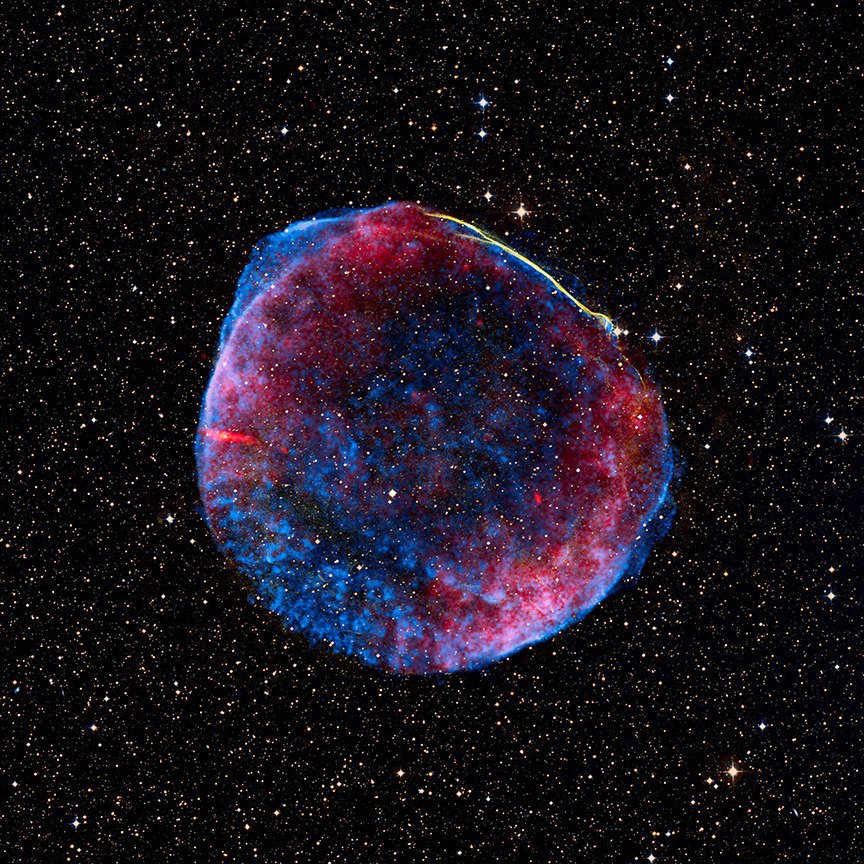A bright flash of supernova lit up the sky of the planet Earth in 1006 AD
The expanding cloud of remnants of the star explosion, which can be found in the southern hemisphere in the constellation Wolf, glows in the entire electromagnetic spectrum.

Photos of NASA, ESA, Zolt Levay (STScI). This composite photograph combines X-ray (blue), optical (yellowish) and radio (red) data.
The object, known as SN 1006, extends for 60 light years, representing the remains of a white dwarf star. The compact white dwarf, which was once part of a double star system, was pulling matter from a companion star by the force of its gravity. The accumulated surplus mass eventually launched a thermonuclear reaction that destroyed the dwarf star.
')
Such supernovae belong to type Ia and always emit approximately the same amount of energy, about 10 51 erg. Due to such stability, they play a very important role in astronomy and serve as “standard candles” or lighthouses, which determine the distances in the Universe. Based on the fact that the explosion energy is constant, and the Universe on a large scale is almost homogeneous, astronomers can calculate the amount of energy that reached the Earth, at what distance the explosion site is located. Thanks to this technique, it was found that the distance to the supernova is 6850 light years.

The highest quality photo of the SN 1006 in the X-ray range from the Chandra Observatory. It was compiled in 2013 in honor of the 50th anniversary of X-ray astronomy.
Chinese and Arab astronomers of those times were amazed at the scale of the event. Arab astronomer Ali ibn Ridwan, while in Egypt, noted:
In confirmation of his words, the monks of the monastery of St. Gall, located at 47.5 degrees north latitude, that on the territory of modern Switzerland, regardless of other astronomers, also observed this event:

This photo was published by astronomer Tunck Tezel in 2006 and dedicated to the one-thousandth anniversary of the supernova. It illustrates the approximate brightness of this event in the night sky.

Photos of NASA, ESA, Zolt Levay (STScI). This composite photograph combines X-ray (blue), optical (yellowish) and radio (red) data.
The object, known as SN 1006, extends for 60 light years, representing the remains of a white dwarf star. The compact white dwarf, which was once part of a double star system, was pulling matter from a companion star by the force of its gravity. The accumulated surplus mass eventually launched a thermonuclear reaction that destroyed the dwarf star.
')
Such supernovae belong to type Ia and always emit approximately the same amount of energy, about 10 51 erg. Due to such stability, they play a very important role in astronomy and serve as “standard candles” or lighthouses, which determine the distances in the Universe. Based on the fact that the explosion energy is constant, and the Universe on a large scale is almost homogeneous, astronomers can calculate the amount of energy that reached the Earth, at what distance the explosion site is located. Thanks to this technique, it was found that the distance to the supernova is 6850 light years.

The highest quality photo of the SN 1006 in the X-ray range from the Chandra Observatory. It was compiled in 2013 in honor of the 50th anniversary of X-ray astronomy.
Chinese and Arab astronomers of those times were amazed at the scale of the event. Arab astronomer Ali ibn Ridwan, while in Egypt, noted:
The new star was a disc-shaped body, which was 2.5 - 3 times brighter than Venus. The sky has noticeably brightened due to the light of the star. The intensity of its light slightly exceeded a quarter of the lunar intensity.
In confirmation of his words, the monks of the monastery of St. Gall, located at 47.5 degrees north latitude, that on the territory of modern Switzerland, regardless of other astronomers, also observed this event:
Miraculously, it is now shrunk in size, then blurred, and sometimes completely extinguished. The star was in the sky for about 3 months in the southernmost part of the sky outside the constellations visible in the sky.

This photo was published by astronomer Tunck Tezel in 2006 and dedicated to the one-thousandth anniversary of the supernova. It illustrates the approximate brightness of this event in the night sky.
Source: https://habr.com/ru/post/362619/
All Articles